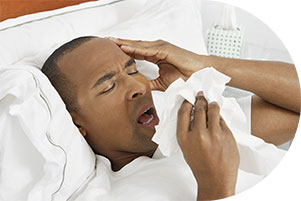Preparing for the Cold and Flu Season

The COVID-19 pandemic has made many things in our lives more complicated, including flu season.
The flu, or influenza, is a viral infection with a variety of symptoms—fever or chills, cough, sore throat, muscle or body aches, and runny nose, to name just a few. These systems are also symptoms of COVID-19. According to the Cleveland Clinic, flu season may start as early as October or as late as January or February.
If you start feeling sick, Dr. Kristin Englund, an infectious disease specialist, told the Cleveland Clinic that it’s important to test for COVID-19 as soon as possible.
“Make sure that you’re not going into work and that you’re isolating yourself until you can get tested and know what you’re dealing with and how best to treat yourself,” Englund said.
Symptoms aren’t the only things the flu and COVID-19 have in common. Many of the guidelines for managing through the flu and COVID-19 are the same. And since the flu and coronavirus spread in similar ways, you can reduce the spread of both with similar precautions, the Cleveland Clinic noted.
The Centers for Disease Control and Prevention (CDC) offers several simple suggestions for how to avoid getting—and if you catch it, spreading—the flu:
- Get the flu shot
The flu vaccine is the “best way to reduce the risk of seasonal flu,” according to the CDC. The CDC also recommends that almost everyone six months and older receive the shot annually. Learn more about the flu vaccine here. - Avoid close contact with people who are sick
And if you are sick, keep your distance from others to help stop the spread of the flu. - Stay home from work and school when sick
- Cover your mouth and nose with a tissue when coughing or sneezing
This may prevent those around you from getting sick. Both the flu and COVID-19 are spread by droplets from the mouth and nose. The Cleveland Clinic recommendations go a step further. Even if you are vaccinated against the flu and COVID-19, it suggests wearing a mask “in public, especially indoors or in crowded outdoor settings.” Englund told the Cleveland Clinic: “I would encourage you to wear masks during the respiratory illness season. There’s a lot of different viruses that can cause harm, not just COVID.” - Wash your hands often
If soap and water are not available, use an alcohol-based hand sanitizer. Click here to learn the five-step process to wash your hands the right way. - Avoid touching your eyes, nose or mouth
Germs can be spread when you touch something with germs on it and then touch your eyes, nose or mouth. - Practice healthy habits
- Clean and disinfect frequently touched surfaces at home and work, especially when someone is ill
- Get plenty of sleep
- Be physically active
- Work on managing stress levels
- Stay hydrated and eat healthy
The Cleveland Clinic has an additional recommendation: Be prepared for the flu by having a few medicine cabinet staples on hand such as a fever reducer like acetaminophen, ibuprofen for muscle aches, cough syrup, and a thermometer.
If you are at greater risk for severe illness because of an underlying condition, the Cleveland Clinic said, “it may also be helpful to have a pulse oximeter at home, which measures the levels of oxygen in your blood.”
Additional Sources:

